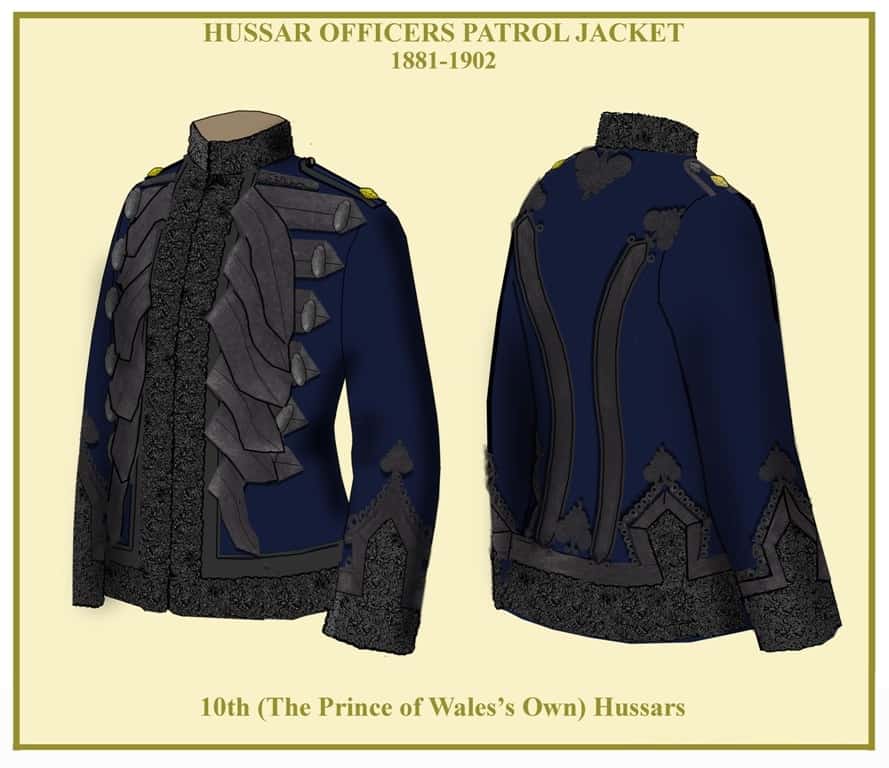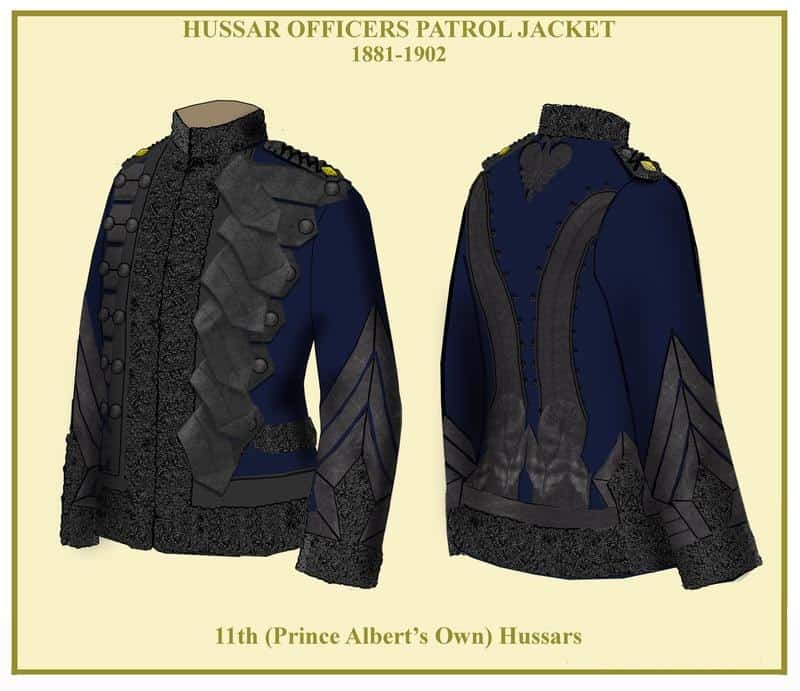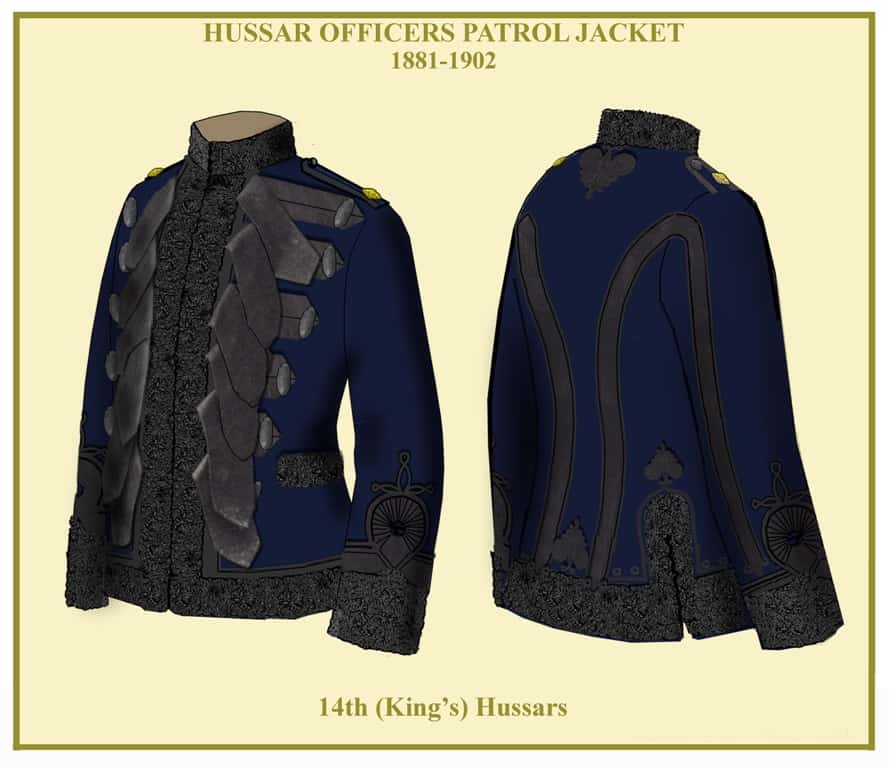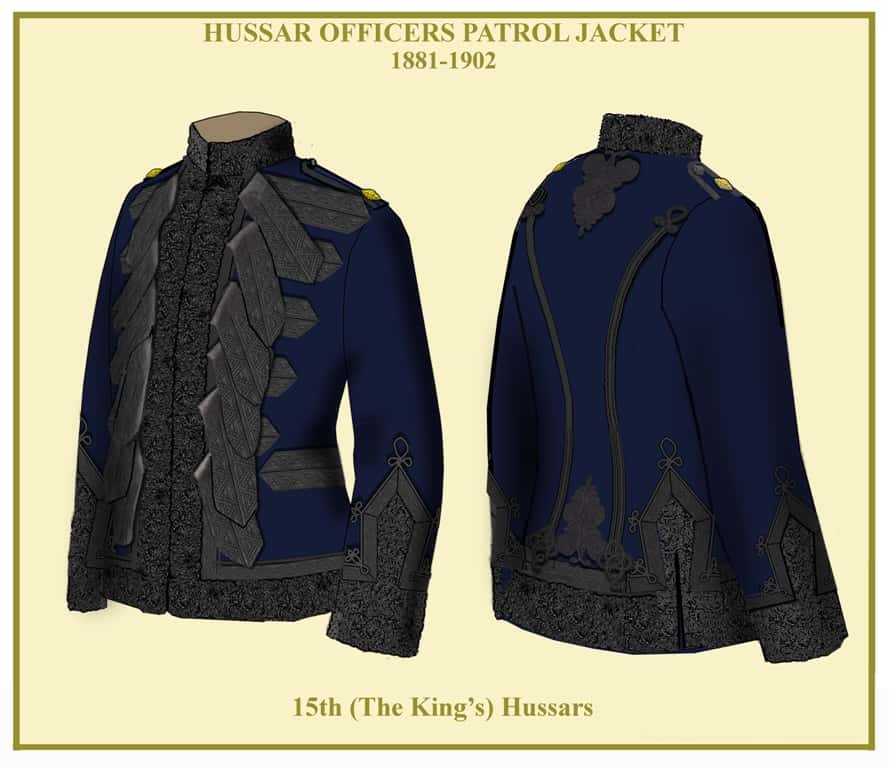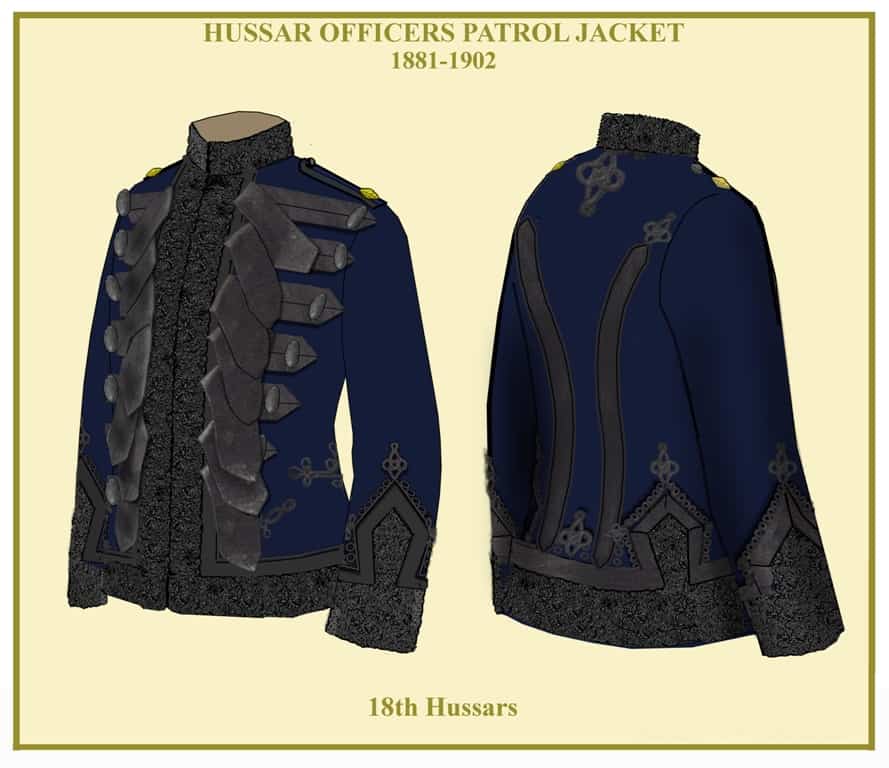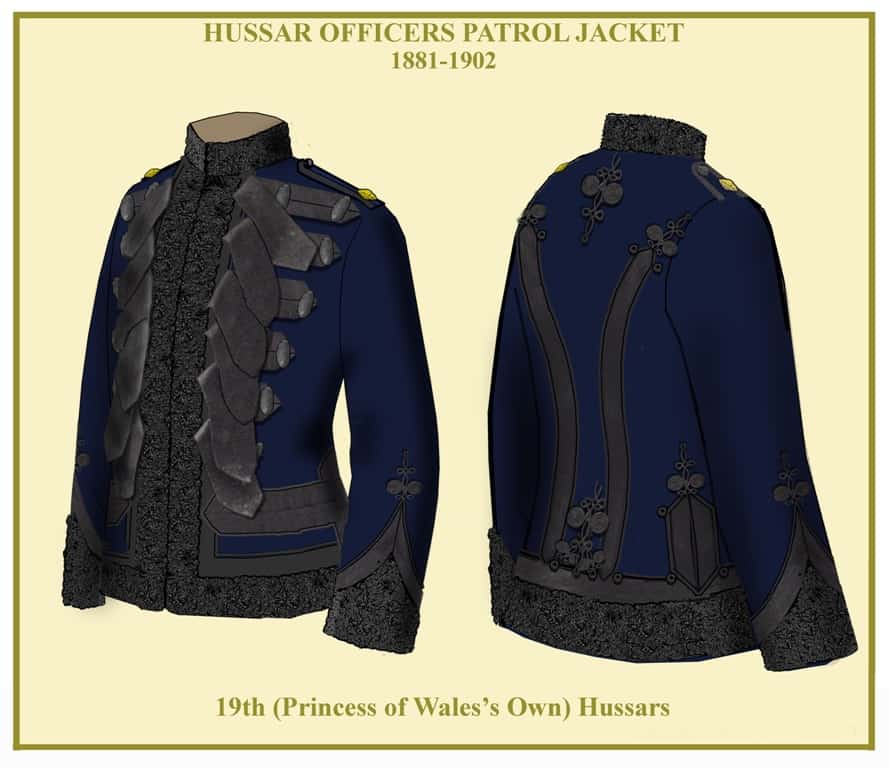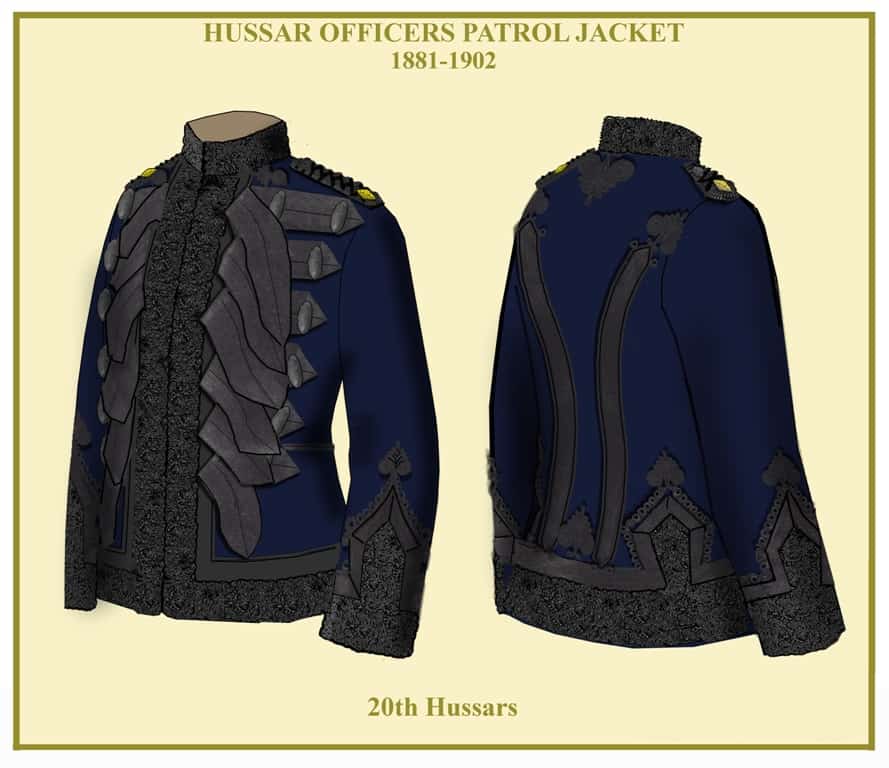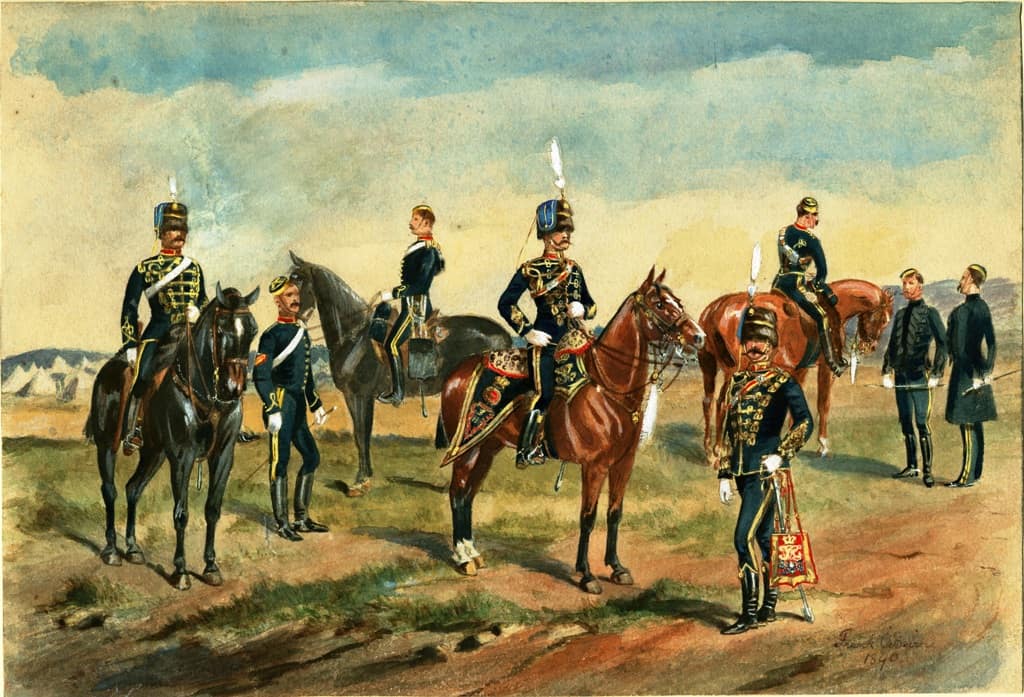UNDRESS CAPS, FROCK COATS, PATROL JACKETS,
STABLE JACKETS & MESS DRESS
FORAGE CAPS
Although various editions of dress regulations referred to the lace on forage caps as being of regimental pattern, there was little to determine what that should be. The 1878 regulation states that the lace should match the trouser lace but photographic evidence suggests that it wasn’t so. More confusion appears in the 1900 regulations where the regimental lace is illustrated but does not indicate what lace goes where. It is apparent from the study of countless photographs that the pillbox caps of most Hussar regiments had a single lace pattern band with a gold Russia braid edging around the crown and gold lace figure on the crown. The exceptions were the 8th Hussars with shamrock pattern band, the 11th Hussars, the 15th Hussars and 18th Hussars with special regimental lace bands. All caps were blue except the 11th which was crimson and the 15th which was scarlet (both without Russia braid edging). The 13th Hussars had the same crown lace as the 14th Hussars.
It should also be remembered that officers frequently exchanged into other regiments and some dress items may not have been immediately replaced on transfer.
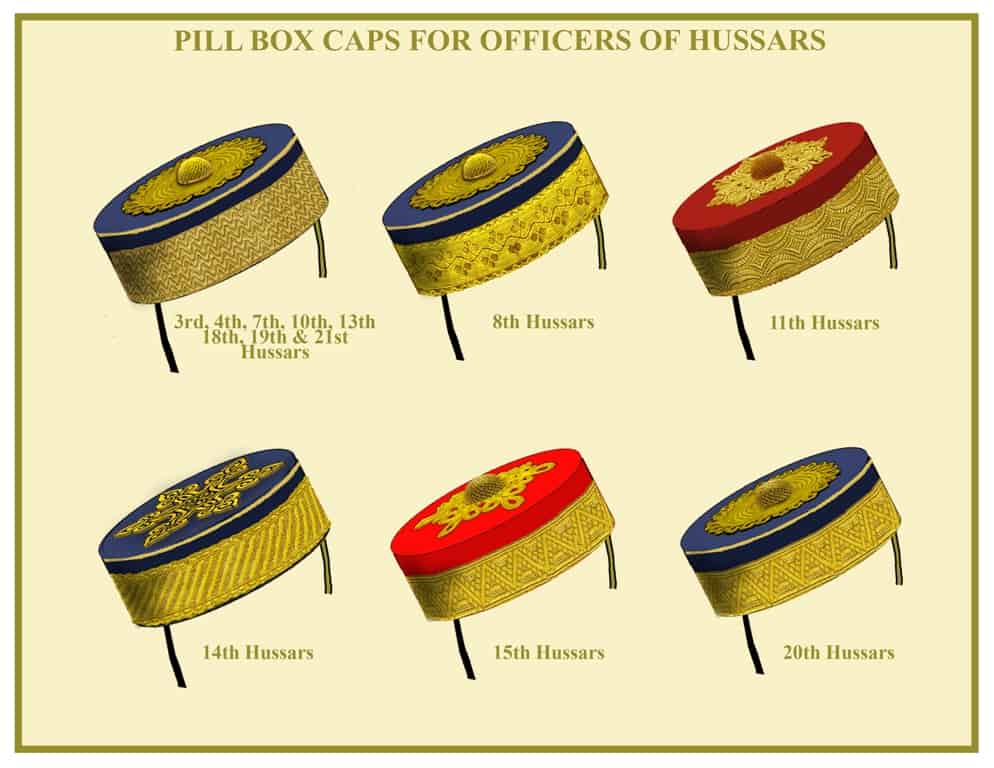
PATROL JACKETS
The last part of the 19th century saw the art of military tailoring at its zenith. A prime example of that art was the undress patrol jacket worn by cavalry regiments, which this writer believes was the most attractive military garment ever conceived. Heavily braided with black mohair lace with drooping tabs on the chest and edged all round with black Astrakhan fur, it was worn by heavy cavalry and lancers as well as hussars.
The heavies began to drop the item in favour of the braided frock coat in the 1890s but hussars did the opposite and towards the end of the century every regiment had its own (and in some cases unique) pattern of jacket. These were all illustrated in the1900 regulations.
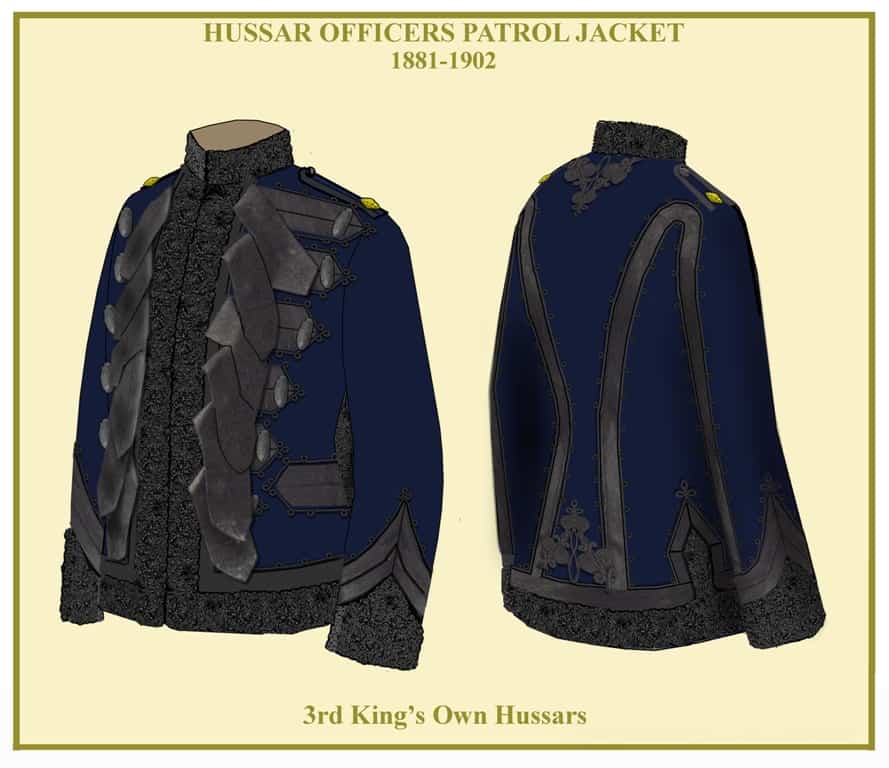
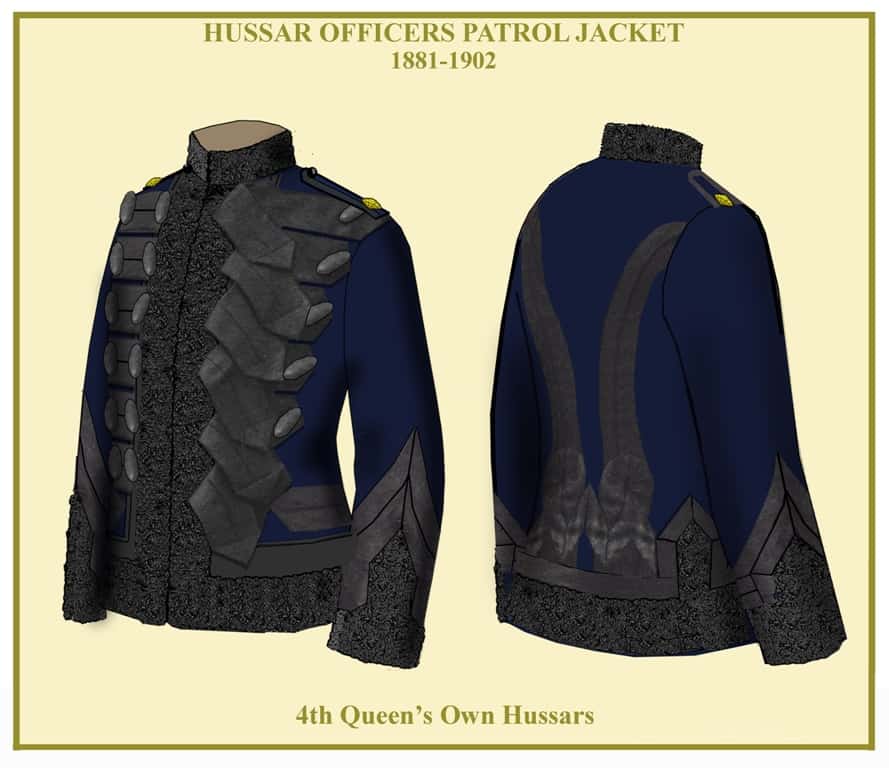
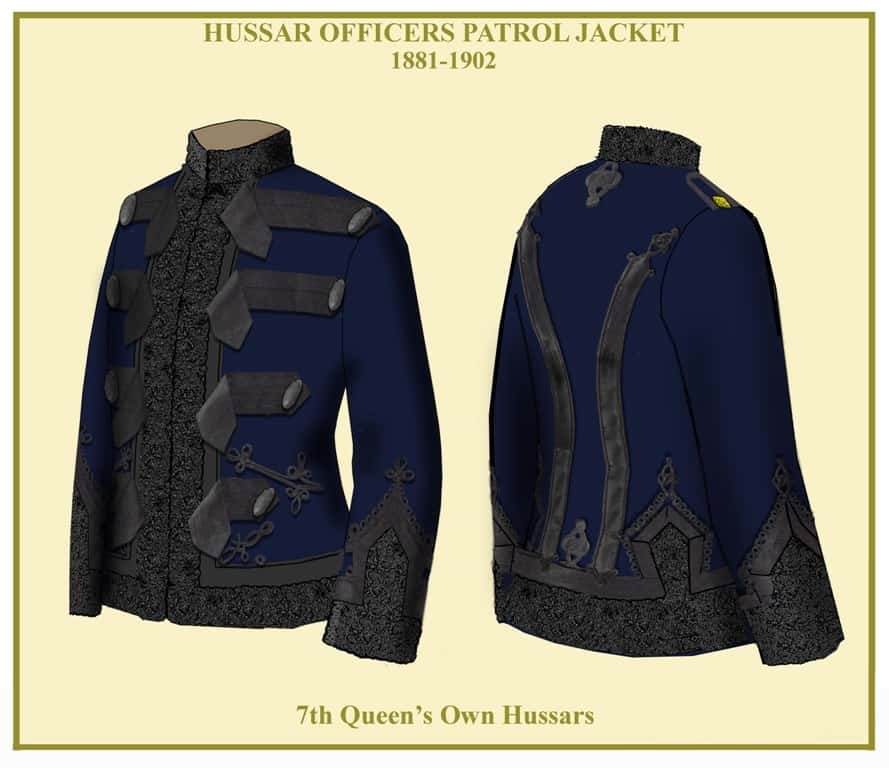
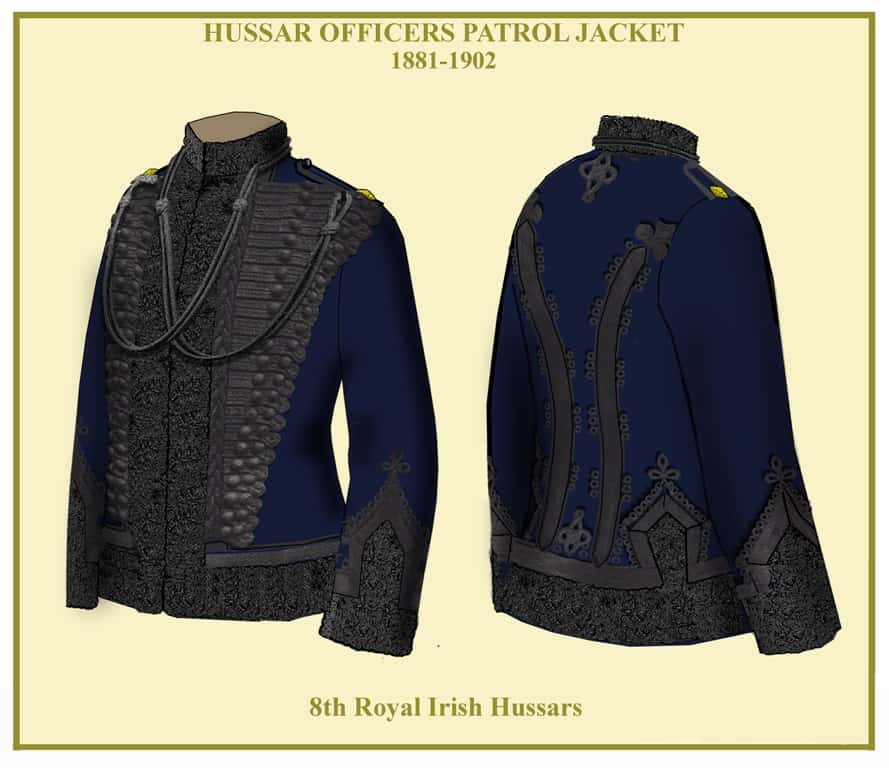
STABLE JACKETS AND MESS DRESS
The stable jacket, or shell jacket had been a feature of undress uniform since the early part of the 19th century. Worn by both officers and men from all branches it was abolished for other ranks in the infantry in 1856 and for officers in 1867 (replaced by the patrol jacket). Thenceforth it was worn as mess dress. Guards and Scottish regiments retained their white shell jackets. By 1881, only cavalry and Royal Horse Artillery wore it for undress, often with the full dress or undress pouch and shoulder belt. It was also worn as mess dress with decorative waistcoats a practice that prevailed throughout the army by the mid-nineties. With the onset of the practical service frock in 1895, the stable jacket went out of use and was abolished in 1902.
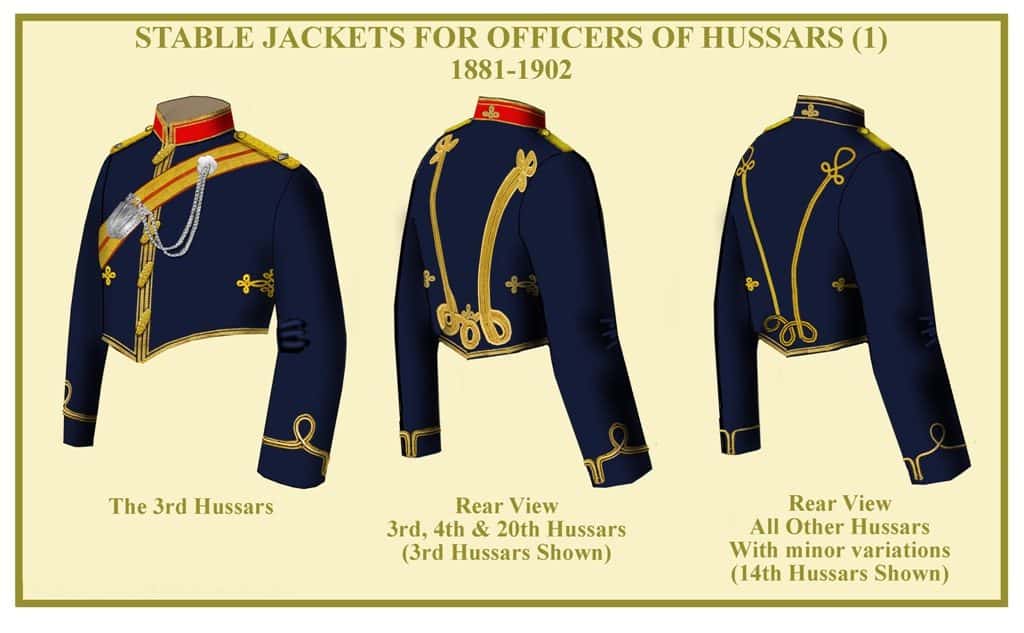
The stable jackets of hussars generally followed the patterns of other cavalry with regimental distinctions. They were dark blue in every case with scarlet collar in the 3rd Hussars and white (buff) in the 13th Regiment. They were generally edged all round with ¼ inch gold regimental lace or round back lace with a tracing in Russia braid. The cuffs were decorated with a simple gold loop sometimes plain, but often with tracing lace above and below ending in knots or loops according to regimental patterns. The rear of the jacket had lace traced on the rear seams terminating in trefoils at the shoulder and triple loops at the waist. The 3rd, 4th and 20th Hussars had wide lace (similar to the dress tunic) while the remaining regiments had double cord lacing, with the arrangement at the waist varying according to regiment.
.
Regiments with different lace arrangements were the 7th and 14th who had Austrian Knots on the cuffs and the 8th, 15th and 18th Hussars who had elaborate distinctions for field officers. The most unique stable jacket was that of the 11th Hussars which had four loops with caps and drops across the chest. This had been worn since the Crimean War. A study of tailor’s pattern book suggests that some regiments changed the design of lace on their jackets more than once. The 19th and 20th Hussars originally had jackets with Austrian knots on the cuffs, but after 1893 they appeared to have conformed with other regiments by having the simple loop.
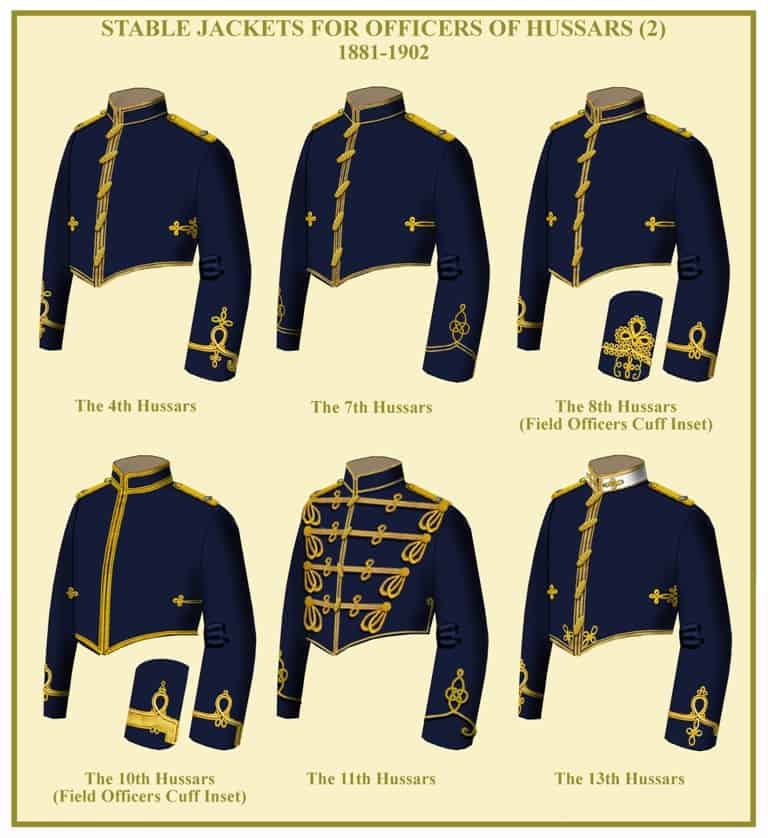
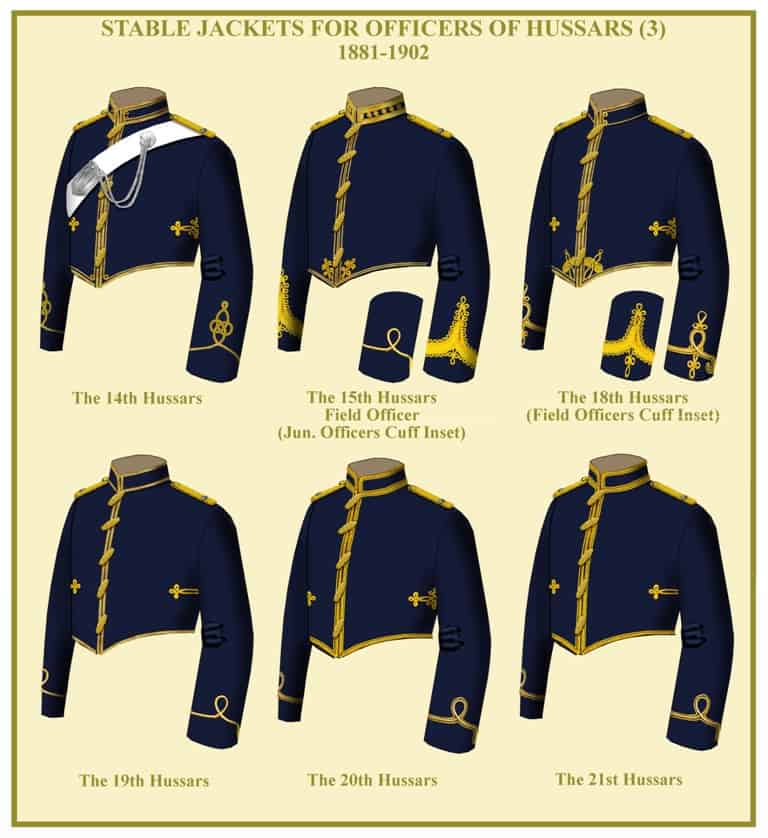
MESS WAISTCOATS
The mess waistcoat was another one of those items where, due to the lack of specific dress regulations, regiments displayed their individuality. Often involving a profusion of gold lace and buttons these garments also showcased the extravagance which officers went to when allowed. Like shell jackets, the designs changed from time to time depending on the whims of commanding officers but by the 1890s they remained constant. For the most part, the regiments in existence before 1858 wore scarlet waistcoats except the 13th Hussars.
However the new regiments adopted a more colourful approach wearing waistcoats reflecting the colour of the busby bag. The 11th Hussars apparently never wore a waistcoat, perhaps because of their elaborately looped shell jacket. Surprisingly, however, the waistcoat never seems to have been adopted by the 8th, Royal Irish Hussars. This was noted in a tailor’s pattern book of the early 1890s.
Regulations finally caught up with mess dress in 1902 when the simpler shell jacket with lapels and plain waistcoat were ordered to be worn. Naturally the regiments were not happy and many hung on to the old mess dress for some years. The 10th Hussars, in fact never (apparently) took up the post 1902 mess dress.
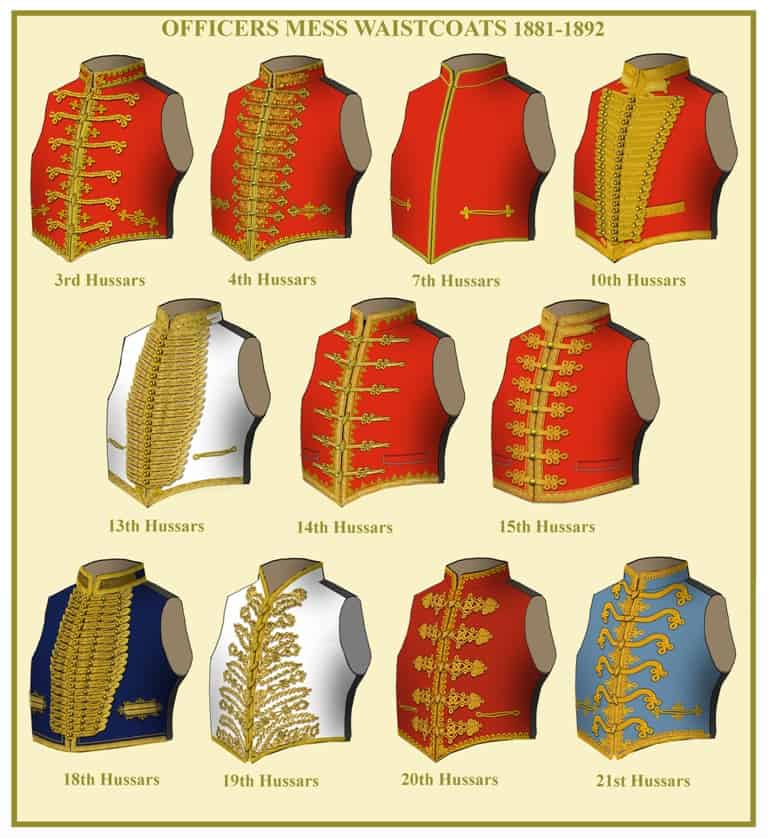
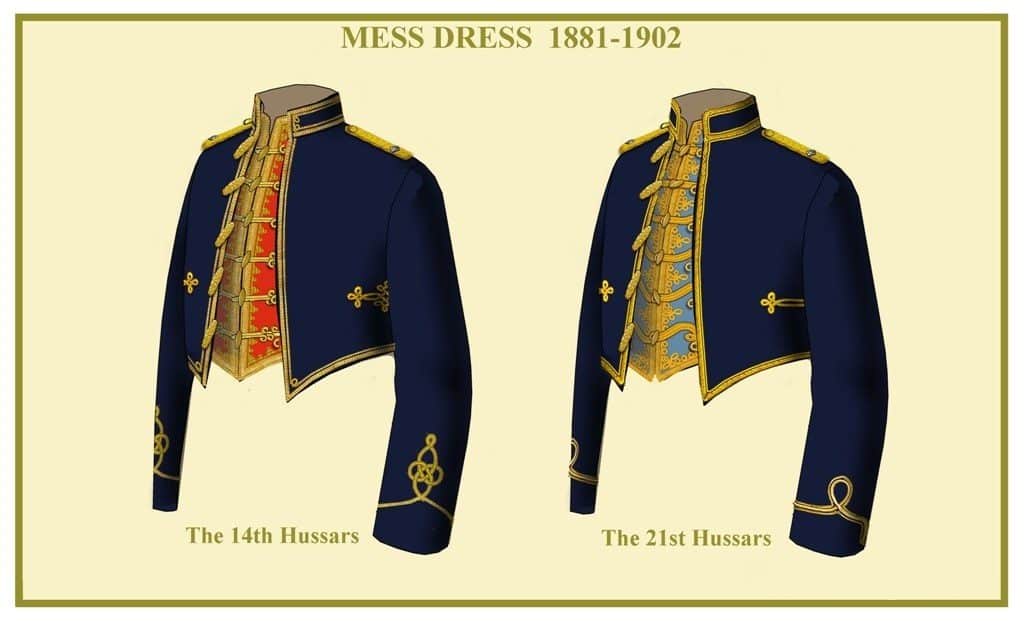
Below are examples of the jackets for the other hussar regiments and except for the 21st Hussars who had converted to Lancers in 1897 and contemporary photos prior to that show their patrol jacket to be much like that of dragoons and lancers without any fur edging.
